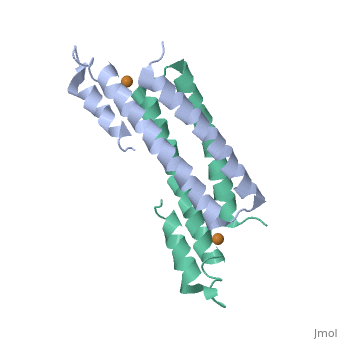Molecular Playground/Metal Responsive Regulators-Fall2001
|
One of the CBI Molecules being studied in the University of Massachusetts Amherst Chemistry-Biology Interface Program at UMass Amherst and on display at the Molecular Playground.
IntroductionIntroduction
Heavy metals such as iron, nickel, copper, and zinc are important cofactors for the functions of many different metalloenzymes. High levels of these heavy metals can also cause damage cellular components, therefore intracellular levels of metals are tightly regulated within the cell. One of the ways that bacteria can regulate intracellular metal levels is by increasing the amount of metal efflux proteins. CsoR and RcnR are members of a large family of metal-responsive DNA-binding proteins, both of which regulate the transcription of metal-specific efflux proteins. CsoR is only responsive to the binding of Cu(I); whereas RcnR is only responsive to the binding of Ni(II) or Co(II).[1]
RcnR and CsoRRcnR and CsoR
In Escherichia coli apo-RcnR blocks the transcription of nickel and cobalt efflux protein RcnA by binding to its promoter region. Although no crystal structures of RcnR is available on the PDB, the Cu(I)-bound CsoR crystal structure from Mycobacterium tuberculosis is available and RcnR is predicted to share a similar fold to CsoR. Upon Ni(II)- or Co(II)-binding, RcnR is released from the DNA allowing the transcription of RcnA facilitating the efflux of Ni(II) and Co(II).[2] CsoR has been characterized in Bacillus subtilis[3] and M. tuberculosis[4] to release from the promoter regions of copper-efflux operons upon binding of Cu(I). The analogous functions of CsoR and RcnR in addition to local sequence similarity (25% identical, 56% similar) suggests a conserved mode of function in this family of metal-responsive DNA-binding proteins.[5]
CsoR StructureCsoR Structure
binds one Cu(I) per monomer. The protein forms a dimer of dimers with a in the tetrameric interface. Each of a dimer unit. Where one monomer is bound to Cu(I) by His61 and Cys65, the other monomer is bound to the metal by Cys35.[6] E. coli RcnR is also tetrameric and has the same protein-to-metal stochiometry.
Research InterestsResearch Interests
The mechanism of DNA binding of the CsoR/RcnR family of metal-responsive transcriptional regulators is still unknown. Additionally, RcnR has an added level of complexity because it is reponsive to both Ni(II) and Co(II) binding. The Maroney Lab at the University of Massachusetts Amherst is interested in the conformational changes of RcnR induced by DNA-, Ni(II)-, and Co(II)-binding.
ReferencesReferences
- ↑ Reyes-Caballero H, Campanello GC, Giedroc DP. Metalloregulatory proteins: metal selectivity and allosteric switching. Biophys Chem. 2011 Jul;156(2-3):103-14. Epub 2011 Apr 5. PMID:21511390 doi:10.1016/j.bpc.2011.03.010
- ↑ Iwig JS, Chivers PT. Coordinating intracellular nickel-metal-site structure-function relationships and the NikR and RcnR repressors. Nat Prod Rep. 2010 May;27(5):658-67. Epub 2010 Mar 5. PMID:20442957 doi:10.1039/b906683g
- ↑ Smaldone GT, Helmann JD. CsoR regulates the copper efflux operon copZA in Bacillus subtilis. Microbiology. 2007 Dec;153(Pt 12):4123-8. PMID:18048925 doi:10.1099/mic.0.2007/011742-0
- ↑ Liu T, Ramesh A, Ma Z, Ward SK, Zhang L, George GN, Talaat AM, Sacchettini JC, Giedroc DP. CsoR is a novel Mycobacterium tuberculosis copper-sensing transcriptional regulator. Nat Chem Biol. 2007 Jan;3(1):60-8. Epub 2006 Dec 3. PMID:17143269 doi:http://dx.doi.org/10.1038/nchembio844
- ↑ Iwig JS, Leitch S, Herbst RW, Maroney MJ, Chivers PT. Ni(II) and Co(II) sensing by Escherichia coli RcnR. J Am Chem Soc. 2008 Jun 18;130(24):7592-606. Epub 2008 May 28. PMID:18505253 doi:10.1021/ja710067d
- ↑ Liu T, Ramesh A, Ma Z, Ward SK, Zhang L, George GN, Talaat AM, Sacchettini JC, Giedroc DP. CsoR is a novel Mycobacterium tuberculosis copper-sensing transcriptional regulator. Nat Chem Biol. 2007 Jan;3(1):60-8. Epub 2006 Dec 3. PMID:17143269 doi:http://dx.doi.org/10.1038/nchembio844
